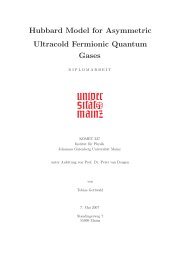5 Hirsch-Fye quantum Monte Carlo method for ... - komet 337
5 Hirsch-Fye quantum Monte Carlo method for ... - komet 337
5 Hirsch-Fye quantum Monte Carlo method for ... - komet 337
You also want an ePaper? Increase the reach of your titles
YUMPU automatically turns print PDFs into web optimized ePapers that Google loves.
5.12 Nils Blümer<br />
G(τ)<br />
0<br />
-0.1<br />
U = 4, T = 0.05<br />
G(τ=2)<br />
-0.2<br />
-0.102<br />
-0.104<br />
-0.331<br />
-0.3 ∆τ = 0.25<br />
Nw , Nm → ∞<br />
-0.332<br />
-0.4<br />
-0.5<br />
0<br />
Nw = 1000<br />
Nw = 10<br />
Nw = 0<br />
2 4<br />
-0.333<br />
1<br />
6<br />
10 100<br />
Nw 8<br />
1000<br />
10<br />
G(τ=0.25)<br />
Fig. 5: Impact of proper warm-up: Green functions estimated from short HF-QMC runs with<br />
varying numberNw of warmup sweeps (see text).<br />
We also use MPI <strong>for</strong> the parallel solution of identical impurity problems, with near-perfect<br />
scaling up to some 20–30 MPI tasks (and reasonable scaling beyond 100 tasks). These limits<br />
could easily be extended by at least a factor of 10 by amortizing the warm-up of the auxiliary<br />
field over several (typically 20) DMFT iterations. It should be noted that the averaging over<br />
multiple independent solutions also stabilizes the procedure.<br />
2.4 Choice of simulation parameters: discretization and number of sweeps<br />
The important practical question how the simulation parameters should be choses is most easily<br />
answered <strong>for</strong> the number of measurement sweeps, at least on the SIAM level (not taking<br />
the DMFT self-consistency into account): since the error scales as Nmeas <strong>for</strong> each observable<br />
(including the Green function), it can be determined from the desired precision.<br />
A much harder question is the appropriate value ofNwarm. A too small value should be avoided<br />
at all costs since it will lead to a systematic bias which is near-impossible to detect in the result<br />
data of a single run. 12 On the other hand, a too large value wastes ressources. We typically use<br />
Nwarm ≥ 1000; in high-precision runs, we devote10% of the sweeps of each serial runs to equilibration<br />
(possibly an overkill which, however, costs only 5% in statistical precision). In order<br />
to quantify the impact of the warm-up at least <strong>for</strong> one test case, we have per<strong>for</strong>med a large number<br />
of independent simulations at fixed ∆τ and <strong>for</strong> fixed hybridization function G with Nwarm<br />
ranging from 1 to 1000. In order to see the effect, these runs have to be short; we have chosen<br />
Nmeas = 100. This, on the other hand, gives rise to very large fluctuations in the measured<br />
Green functions as shown in the main panel in Fig. 5. At this level, a possible effect ofNwarm is<br />
hidden in the noise. Averaging over a large number (here 1000) of realizations, however, allows<br />
12 However, one might keep track of the relative probabilities of the visited configurations (or rather of their<br />
logarithm) and derive a cutoff from the number of sweeps needed <strong>for</strong> reaching a typical probability level <strong>for</strong> the<br />
first time.<br />
-0.1<br />
τ













